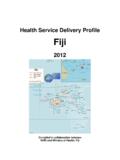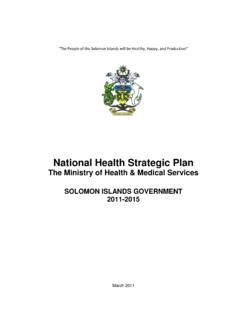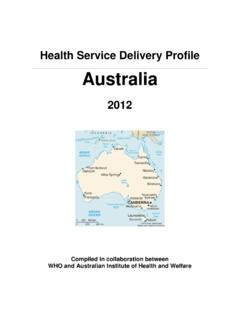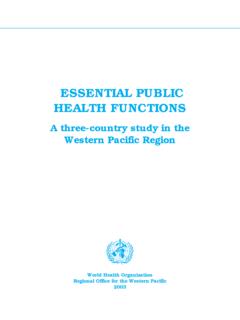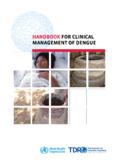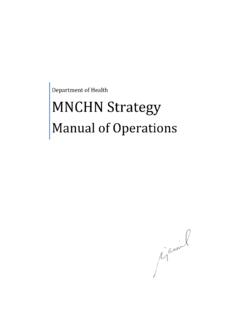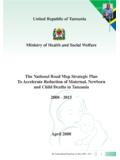Transcription of Health Service Delivery Profile Philippines
1 Health Service Delivery Profile Philippines 2012 Compiled in collaboration between WHO and Department of Health , Philippines Philippines Health Service Delivery Profile , 2012 1 Philippines Health Service Delivery Profile Demographics and Health situation Positioned on the western edge of the Pacific Ocean, on the south-eastern rim of Asia, the Philippines is the second-largest archipelago on the planet, with over 7,107 islands In 2010, the population of the Philippines was million, with a growth rate of per year. There are 80 provinces, 138 cities and 1,496 municipalities and half the population ( ) live in urban areas, and of that, 44% live in slums. Both urban and rural poverty are high but steadily decreasing.
2 The population is highly fragmented across the islands and with 180 ethnic groups. Malays make up the majority and there are tribes of indigenous peoples in mountainous areas throughout the country. The majority of the population is Christian and there is a Muslim minority concentrated in the south. Table 1. Key development indicators in the Philippines Key development indicators Measure Year Human development index 2011 Gini coefficient 2000-2011 Total Health expenditure GDP 2009 GDP per capita USD$2,370 2011 Proportion of population below poverty line 2009 Literacy rate (male/female) (%) 2008 Life expectancy at birth years 2011 Infant mortality rate 22 per 1,000 live births 2011 Maternal mortality rate 221 per 100,000 live births 2011 Health Service Delivery is based on a Western biomedical model of Health initially introduced during the Spanish colonial era and strengthened during American colonization.
3 This Western system is superimposed on a pre-existing alternative model of Health care based on a mix of folk and herbal medicines, religious beliefs, and traditional practices that has persisted throughout the country. Indicators of Health status have steadily improved since the 1970s. However, there is a high inequality in many Health outcomes between socio-economic classes and disparities between geographical regions. The top five causes of death include heart and cerebrovascular diseases, malignant neoplasm, pneumonia, and tuberculosis.. The top five causes of morbidity include acute respiratory infection, ALRTI and pneumonia, bronchitis, hypertension and acute watery diarrhoea.
4 Health system strategies, objectives and legislation Health Functions are largely devolved to provinces and municipalities. The Local Government Code (1991) outlines the roles of different levels in Health care, including barangay (village), municipality and province. The Aquino Health Agenda: Achieving Universal Health Care for All Filipinos is the Philippines Government s continuing commitment to Health sector reform and achieving the Millennium Development Goals (MDGs). The National Objectives for Health (2011-2016) sets all the Health program goals, strategies, performance indicators and targets that lead the Health sector towards achieving it s primary goal of Kalusugan Pangkalahatan (KP), or universal Health care.
5 The overall goal is to achieved the Health system goals of financial risk protection, better Health outcomes and responsive Health system and it includes three strategic thrusts: 1) financial risk protection through expansion of the National Health Insurance Program, enrolment and benefit Delivery 2) improved access to quality hospitals and Health care facilities and 3) Attainment of the Health related MDGs The Aquino Health Agenda s six strategic instruments are Health financing, Service Delivery , policy, standards and regulation, governance, human resources, and Health information. Philippines Health Service Delivery Profile , 2012 2 Legislation that forms the regulatory framework for Health system functioning and public Health in the Philippines includes the following: Organ Donation Act (1991); Hospital Licensure Act; Pharmacy Act, Dangerous Drugs Act (1972) and 2002, Generics Act of 1988; Republic Act No.
6 7600 - Rooming-in- and Breastfeeding Act of 1992; National Blood services Act of 1994; Magna Carta for Disabled Persons; National Health Insurance Act of 1995; Traditional and Alternative Medicine Act (TAMA of 1997); HIV Prevention and Control of 1988 philippine Food Fortification Act of 2000; Tobacco Regulation Act of 2003 ; Expanded Senior Citizens Act of 2003; Newborn Screening Act of 2004; the Universally Accessible Cheaper and Quality Medicines Act (2008), and the Food and Drug Administration Act (2009) ( ) PhilHealth, the country s national Health insurance program, is governed by the National Health Insurance Act of 1995 or the Republic Act 7875 which replaced the Medicare Act of 1969.
7 PhilHealth is mandated to provide Health insurance coverage and ensure affordable, acceptable, available and accessible Health care services for all citizens of the Philippines and is mandated to regulate public and private providers through accreditation in compliance with its quality guidelines, standards and procedures. Service Delivery model The Department of Health (DOH) is responsible for developing Health policies and programmes, regulation, performance monitoring and standards for public and private sectors, as well as provision of specialized and tertiary level care. The DOH Centres for Health and Development (CHDs) are the implementing agencies in provinces, cities and municipalities, and link national programs to Local government units (LGUs).
8 The CHDs are the DOH offices at the regional level. They assist the LGUs in the development of ordinances and localization of national policies, provide guidelines on the implementation of national programs at the LGU levels, monitor program implementation, and develop support system for the Delivery of services by LGUs. Health Service Delivery has evolved into dual Delivery systems of public and private provision, covering the entire range of interventions with varying degrees of emphasis at different Health care levels. Public services are mostly used by the poor and near-poor, including communities in isolated and deprived areas. Private services are used by approximately 30 % of the population that can afford fee-for- Service payments.
9 The Service package that is supported by the government is outlined by PhilHealth. Coverage is reported by PhilHealth to be 74 million or 82% of the population at end December 2011. However, the services covered are not comprehensive, copayments are high and reimbursement procedures are difficult. The dominant private sector is made up of large Health corporations and smaller providers. Health maintenance organisations are also present. Professional organizations contribute to continuing education, clinical practice guidelines development, advocacy, and influence policy and regulation. Opportunities for community participation in Health are through the barangay Health workers who come from the local community, and representatives from civil society and the private sector who participate in LGU policy-making local Health boards.
10 The provider network In the public sector the Department of Health (DOH) delivers tertiary services , rehabilitative services and specialized healthcare, while the local government units (LGUs) deliver Health promotion, disease prevention, primary, secondary, and long-term care. Primary Health services are delivered in barangay (village) Health stations, Health centers, and at hospitals. Philippines Health Service Delivery Profile , 2012 3 Table 2. Summary of Health services and providers in the Philippines , 2012 Heath services Public sector provision Private sector provision Health promotion Health education Family planning Maternity care Child care Nutrition and food safety Lifestyle-related or non-communicable diseases Communicable diseases Environmental Health and sanitation Health centres Barangay Health stations National programs and agencies provide technical support Activities are highly variable and depend on the local government unit Community Health teams provide education and information at family levels in the community.
